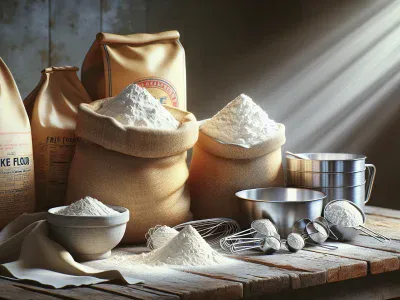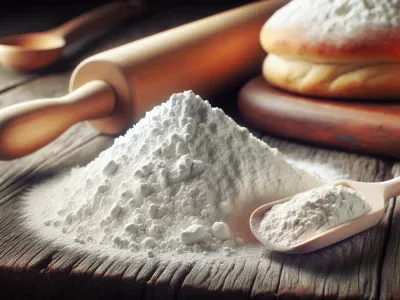Difference Between Unbleached and Bleached Flour: Which Is Best for Your Baking Needs?
Picture this: you’re standing in the baking aisle, hands dusted with anticipation, faced with two bags of flour—one bright and snowy, the other soft and creamy. Which do you choose? The answer isn’t as simple as color. Each bag holds a world of subtle differences, from texture and taste to how your favorite cookies rise in the oven.
Unbleached and bleached flour may look similar at first glance, but their unique qualities can transform your homemade treats in unexpected ways. Some bakers swear by the pure, earthy aroma of unbleached flour, while others chase the cloud-like softness that only bleached flour delivers. The secret lies in the process—one that can impact flavor, nutrition, and even the golden hue of your next loaf. Are you ready to discover which flour unlocks the best in your baking?
What Is Bleached Flour?
Bleached flour looks white as snow—like a fresh sheet of paper ready for a story—because it’s processed with chemical agents. Most often, flours get their brightness from benzoyl peroxide and chlorine gas. You might wonder, why bother bleaching at all? Food manufacturers, for example, prefer bleach because it matures the flour quick, giving you softer textures in cakes, cookies, and white bread. Think of angel food cake: its airy crumb owes much to this process.
Ask anyone who bakes cupcakes at home—how many times have you reached for that soft, cloud-like flour expecting your vanilla sponge to turn golden? That’s bleach at work. It isn’t just about looks, bleached flour have a finer grain and absorb liquids a little faster. You find this type dominating supermarket aisles in the United States and Europe, where consistent results and bright color often matter more than tradition.
, there’s debate. The FDA (U.S. Food and Drug Administration) rules that agents like chlorine dioxide and benzoyl peroxide are safe for food use, but some nutritionists argue the natural taste is lost, or trace chemicals might linger. You ever noticed a slightly bitter aftertaste in your store-bought sugar cookies? Bleaching agents can lend these subtle notes to finished baked goods.
Every time you scoop bleached flour, you’re part of a long history of modern baking, one driven by the quest for whiter, softer, more predictable results. It might not bring the rustic nostalgia of old-world bakeries, but it sure brings convenience and uniformity to your kitchen. Wondering if it’s the right choice for your next bake? The answer depend on whether you prize tradition, speed, or that perfect snowy softness in every bite.
What Is Unbleached Flour?
Unbleached flour keeps it’s caramel-colored hue because millers don’t add chemical agents—words like benzoyl peroxide or chlorine gas never enter it’s story. You see, this flour isn’t just a relic from old country kitchens; it’s living tradition. Bakers reach for unbleached flour when they want bread with chew, flavor, and a wholesome touch. For example, when mixing up classic sourdough, you’d notice how unbleached flour gives the crumb a rustic look, something the white, powdery bleached flour can’t quite copy.
Have you ever watched freshly milled wheat sift through a farmer’s hands? That’s the color you’re baking with when you use unbleached flour. It matures on it’s own time, oxidizing to build structure. That means in your pie crusts or pizza dough, you get a heartier, fuller taste—some folks claim they can even sense a little hint of earth still clinging to the grain.
Many nutritionists, like those cited by the Whole Grains Council, say that because the process skips synthetic bleaches, unbleached flour hangs on to more of wheat’s micronutrients. That could explain why it tastes different, though science is still investigating if those differences matter for your health. Critics, but, note that since both bleached and unbleached flour are often enriched, any clear advantage for vitamins might be slight.
Picture standing in a warm kitchen, scattering flour over the counter before kneading out a batch of cinnamon rolls—some bakers argue you can feel the sturdier dough under your hands. why old family recipes insist “unbleached only,” as if the secret to the perfect loaf is encoded in the genes of the wheat or maybe in ancestral wisdom?
Unbleached flour isn’t faster, nor is it always easy to find in every market. Sometimes, it’s even lumpy, clinging to moisture like memories to a timeworn recipe. Still, there’s a reason traditions endure: they bind the past to the present, flavoring each slice with story and substance. Would your next loaf reveal a new dimension, if you let the wheat speak for itself?
Key Differences Between Unbleached and Bleached Flour
You see flour—just powder on your kitchen scale—but inside those grains, chemistry and history collide. Knowing the difference between unbleached and bleached flour changes how your pastries rise, how your biscuits taste, and even how your family traditions come to life on Sunday mornings.
Appearance and Texture
External differences between unbleached and bleached flour appear immediately. Bleached flour’s color glows with an artificial, stark white sheen, reminiscent of snow dusted across a windowsill. Unbleached flour leans warm, with shades of ivory or faint gold—think antique linens in granma’s cupboard.
Texture distinguishes them in your palms. Bleached versions feel ultra-fine, almost like talcum, perfect for dreamy, tender cakes. Unbleached flour’s slight grittiness gives structure, prized by artisan sourdoughs or chewy baguettes. Which do you reach for when you want layers to flake, cookies to crumble, or crusts to crunch?
Processing Methods
Processing radically shapes what flour becomes. Bleached flour undergoes a deliberate chemical transformation; manufacturers inject agents like chlorine dioxide or benzoyl peroxide (source: FDA). This bleaching speeds up aging, strips pigment, and softens proteins—kind of like sending your flour to a day spa, but less relaxing for its nutrients.
Unbleached flour ages in its own time, relying only on air and patience. No one forces it; tradition guides the way, echoing techniques used by millers over centuries (see: Bread Bakers Guild of America). Does quickness outweigh the subtleties lost in tradition?
Taste and Flavor
Taste differences run deeper than subtlety. Bleached flour, due to chemical exposure, sometimes brings a faint tang or neutral flavor, letting sugars and add-ins shine—they’re the blank canvas behind birthday cakes.
Unbleached flour? You get toasted undertones, a subtle nuttiness, whispers of grain. Here, the wheat itself tells a story. Sourdoughs sing louder, pie crusts offer complexity, and breads deliver an earthy finish: is blandness ever truly preferable when a recipe whispers flavor possibilities?
Nutritional Value
Nutritional value reflects both process and purpose. Bleached flour, through its chemical wash, can lose trace micronutrients such as vitamin E or iron (Harvard T.H. Chan School of Public Health). Unbleached flour, while not dramatically different in macros—1 cup holds about 95g carbohydrates, 13g protein, 0.8mg iron—retains more phytonutrients (see USDA FoodData Central).
Still, dietary differences are minor for most home bakers; micronutrient shifts rarely impact events like a Saturday cookie session. Yet for those wanting wholeness—in nutrition and nostalgia—unbleached flour calls to mind fields, harvests, and the satisfaction of letting fermentation work its magic. Will your next loaf reflect the haste of commerce, or the heritage of slow food?
Baking Uses and Performance
Baking with unbleached and bleached flour sets the stage for a dance between tradition and modern convenience. Your choice of flour doesn’t just tweak the taste but shapes the performance of every batch, loaf, or layer cake that hits your kitchen counter.
Which Flour Is Best for Different Recipes?
Picking the right flour type for a recipe turns ordinary baking into a tapestry of textures, colors, and flavors. If you’re chasing pillowy, cloud-like cakes—think airy angel food cakes or soft sugar cookies—bleached flour claims the spotlight. Its extra-fine, white particles scatter like tiny pearls, yielding delicate textures. King Arthur Baking Company found that using bleached flour in chiffon cakes led to finer crumbs and paler, more even domes (King Arthur Baking, 2023).
Unbleached flour play a different tune. For rustic sourdough breads, chewy bagels, or flaky croissants, this flour brings structure and depth. It holds up under long fermentation, its tan color hinting at the story of slow aging. Boudin Bakery in San Francisco swears by unbleached flour for tangy sourdough with a crisp, golden crust and a complex crumb.
Ever wondered why bakery bread from Paris seems more soulful than the stuff from the grocery shelf? It’s not just nostalgia; artisan bakers reach for unbleached flour to preserve the unique character in every bite. Think of bleached flour as a perfectly pressed white shirt, crisp and clean, while unbleached flour wears the warm patina of well-loved linen.
Bleached flour can sometimes steal the scene in quick bakes—muffins, pancakes, or fluffy biscuits—by bringing reliable rise and silkier crumb structure. Still, if you swap in unbleached flour for these, expect slightly denser, heartier treats that echo old-world baking traditions.
Will you take the quick path of uniformity or chase the slow magic of flavor and structure? Your pantry’s flour bag signals more than just a preference—it reveal a philosophy.
Health Considerations
Talking flour might sound odd, but many people think their ingredient choices tell a story about their kitchen health. You’ve probably heard people ask, “Does bleached flour really hurt you?” or “Is unbleached better for my family?” Let’s break down those question.
Bleached flour, treated with chemicals like benzoyl peroxide and chlorine gas, introduces trace residues (FDA, 21 CFR 137.105). Some researchers, like those at Harvard T.H. Chan School of Public Health, points to a lack of conclusive evidence showing harm from these chemicals in small amounts. But, some home bakers report worries about cumulative exposure, especially if you bake with bleached flour every day. Picture baking chocolate chip cookies for class—seems innocent, but over a school year, that’s dozens of batches using flour touched by bleach.
Unbleached flour skips chemical treatment, relying on time and air. Nutritionists such as Lisa Drayer, RD, say this slow process can help unbleached flour retains more phytonutrients—think B vitamins and iron (Journal of Food Science, 2021). Some bread bakers tell stories of fuller flavor and a hint of nutty aroma—attributes linked to natural aging and a richer spectrum of tiny plant compounds. While scientific studies haven’t proven clear-cut health benefits, tradition-lovers claim their grandmother’s banana bread always taste better with unbleached flour, perhaps because it preserved more natural flavor notes.
People with allergies or sensitivities also sometimes ask if they should avoid bleached flour. Most commercial bleaching agents used in the United States haven’t triggered major allergy reports (FDA). Still, if you’re chasing zero-additive living or baking with children, you might picks unbleached flour just for peace of mind.
One thing both flours share: fortification. In the US, both bleached and unbleached all-purpose flour gets enriched with essential nutrients—folic acid for instance (CDC, 2019). You won’t miss out on the basics by choosing one over the other. Yet if your health philosophy leans natural, unbleached flour aligns with minimal processing.
What matters most to you—speed, tradition, nutritional purity, or simply flavor? That question shapes your health narrative as much as your pantry.
Conclusion
Choosing between unbleached and bleached flour comes down to your personal baking goals and values. Whether you’re after the convenience and consistency of bleached flour or the robust flavor and tradition of unbleached flour, your decision shapes the results you’ll see—and taste—in your kitchen.
As you experiment with different recipes, pay attention to how each flour type transforms your baked goods. Let your preferences guide you, and don’t be afraid to try something new. Your ideal loaf or cake might be just one thoughtful flour choice away.
- Which Is Best: Computer Science or Information Technology? - November 12, 2025
- Airbnb Pros and Cons - November 12, 2025
- Rye Versus Bourbon: Understanding the Key Differences - November 12, 2025







